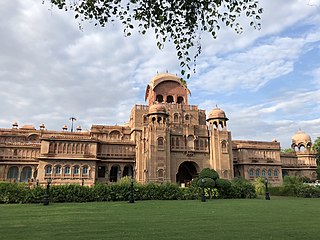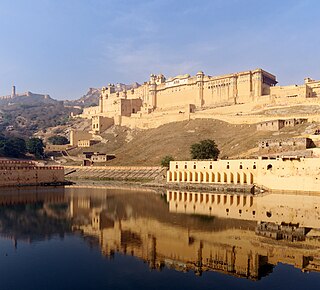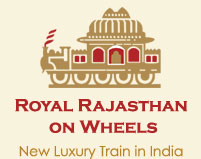This article relies largely or entirely on a single source .(July 2020) |


Raj Mahal is the palace of the erstwhile Maharaja of Jaipur in Jaipur, Rajasthan.
This article relies largely or entirely on a single source .(July 2020) |


Raj Mahal is the palace of the erstwhile Maharaja of Jaipur in Jaipur, Rajasthan.
The original construction dates back to 1729 and was renovated and changed over time. In 1821 it became the official residence of the British resident of Rajputana. It was renovated into the Art Deco style. After independence in 1958 Maharaja Sawai Man Singh II made it into his private residence. [1]
Visitors included Queen Elizabeth II and The Duke of Edinburgh, Jackie Kennedy, the Shah of Iran, Lord Mountbatten and Lady Mountbatten, Charles, Prince of Wales and Princess Diana. [1]
Interior designer Adil Ahmad was commissioned to restore the palace as it was converted into a luxury hotel. [1]

Jaipur, formerly Jeypore, is the capital and largest city of the Indian state of Rajasthan. As of 2011, the city had a population of 3.1 million, making it the tenth most populous city in the country. Jaipur is also known as the Pink City, due to the dominant colour scheme of its buildings. It is also known as the Paris of India, and C. V. Raman called it the Island of Glory. It is located 268 km from the national capital New Delhi. Jaipur was founded in 1727 by the Kachhwaha Rajput ruler Jai Singh II, the ruler of Amer, after whom the city is named. It was one of the earliest planned cities of modern India, designed by Vidyadhar Bhattacharya. During the British Colonial period, the city served as the capital of Jaipur State. After independence in 1947, Jaipur was made the capital of the newly formed state of Rajasthan.

Bikaner is a city in the northwest of the state of Rajasthan, India. It is located 330 kilometres (205 mi) northwest of the state capital, Jaipur. Bikaner city is the administrative headquarters of Bikaner District and Bikaner division.

The Hawa Mahal is a palace in the city of Jaipur, India. Built from red and pink sandstone, it is on the edge of the City Palace, Jaipur, and extends to the Zenana, or women's chambers.

The Kachhwaha is a Rajput clan found primarily in India. Sometimes families within the clan ruled a number of kingdoms and princely states, such as Jaipur, Bihar, Uttar Pradesh, Madhya Pradesh, Alwar and Maihar.

Amer Fort or Amber Fort is a fort located in Amer, Rajasthan, India. Amer is a town with an area of 4 square kilometres (1.5 sq mi) located 11 kilometres (6.8 mi) from Jaipur, the capital of Rajasthan. The town of Amer and the Amber Fort were originally built by Raja Man Singh and additions were, later, made by Sawai Jai Singh. Located high on a hill, it is the principal tourist attraction in Jaipur. Amer Fort is known for its artistic style elements. With its large ramparts and series of gates and cobbled paths, the fort overlooks Maota Lake, which is the main source of water for the Amer Palace.

Major General Maharaja Sawai Man Singh II GCSI GCIE was an Indian prince, government official, diplomat and sportsman.

Lt. Col, Brig. (Hon.), Maharaja Sawai Bhawani Singh MVC was an Indian Army officer and a entrepreneur.

Jal Mahal is a palace in the middle of the Man Sagar Lake in Jaipur city, the capital of the state of Rajasthan, India. The palace was originally constructed in 1699; the building and the lake around it were later renovated and enlarged in the 18th century by Maharaja Jai Singh II of Amber.

Nahargarh Fort stands on the edge of the Aravalli Hills, overlooking the city of Jaipur in the Indian state of Rajasthan. Along with Amer Fort and Jaigarh Fort, Nahargarh once formed a strong defence ring for the city. The fort was originally named Sudershangarh, but it became known as Nahargarh, which means 'abode of tigers'. The popular belief is that Nahar here stands for Nahar Singh Bhomia, whose spirit haunted the place and obstructed construction of the fort. Nahar's spirit was pacified by building a temple in his memory within the fort, which thus became known by his name.

Samode Palace, Samode Haveli and Samode Bagh (Garden) are heritage monuments and structures built by the noble feudatory with the hereditary title of 'Maha Rawal' or 'Maha Saheb’ of the Amber and Jaipur principality in Rajasthan, India. All three have rich history of several hundred years and display a fusion of Mughal and Rajasthani art and architecture. They are now part of the Heritage group of hotels under the flagship name of "Samode" that are run by the hereditary owners of these structures. The Samode Palace is located 40 kilometres (25 mi) north of Jaipur city, the Samode Haveli is close to Jaipur and the Samode Bagh or Garden, 4 kilometres (2.5 mi) from the palace which is also run as a luxury hotel.

The Rambagh Palace in Jaipur, Rajasthan is the former residence of the Maharaja of Jaipur located 5 miles (8.0 km) outside the walls of the city of Jaipur on Bhawani Singh road.

Fort Madhogarh is located in Madhogarh Village, 42 km from Jaipur off the Jaipur - Agra highway. Fort Madhogarh was built by Madho Singh Ji nearly 400 years ago and renovated and converted into heritage hotel by Thakur Bhawani Singh Ji in July 2000.
The Royal Orient is an Indian luxury tourism train that runs between Gujarat and Rajasthan, covering important tourist locations in the two states.

The Royal Rajasthan on Wheels is a luxury tourist train run by Indian Railways. It is modelled on the Palace on Wheels, and follows a similar route through Rajasthan. Tourists are taken to several important tourist, wildlife and heritage sites across Rajasthan. It is now known as Palace on wheels.

Rajasthan is one of the most popular tourist destinations in India, for both domestic and international tourists. Rajasthan attracts tourists for its historical forts, palaces, art and culture with its slogan "Padharo mhare desh", now its changed. Every third foreign tourist visiting India travels to Rajasthan as it is part of the Golden Triangle for tourists visiting India.

The City Palace, Jaipur was established at the same time as the city of Jaipur, by Maharaja Sawai Jai Singh II, who moved his court to Jaipur from Amber, in 1727. Jaipur is the present-day capital of the state of Rajasthan, and until 1949 the City Palace was the ceremonial and administrative seat of the Maharaja of Jaipur. The Palace was also the location of religious and cultural events, as well as a patron of arts, commerce, and industry. It now houses the Maharaja Sawai Man Singh II Museum, and continues to be the home of the Jaipur royal family. The palace complex has several buildings, various courtyards, galleries, restaurants, and offices of the Museum Trust.The MSMS II Museum Trust is headed by chairperson Rajamata Padmini Devi of Jaipur. Princess Diya Kumari runs the Museum Trust, as its secretary and trustee. She also manages The Palace School and Maharaja Sawai Bhawani Singh School in Jaipur. She founded and runs the Princess Diya Kumari Foundation to empower underprivileged and underemployed women of Rajasthan. She is also an entrepreneur. In 2013, she was elected as Member of the Legislative Assembly of Rajasthan from the constituency of Sawai Madhopur.

The Maharajas' Express is a luxury tourist train owned and operated by Indian Railway Catering and Tourism Corporation (IRCTC). It serves four routes across North-West and Central India, mainly centered on Rajasthan between the months of October and April.
Diya Kumari is an Indian politician. She is a member of Indian Parliament from Rajsamand parliamentary seat, and a member of the Bharatiya Janata Party.
The Raj Palace in Jaipur Rajasthan, India is more than two and a half centuries old palace converted into a grand heritage hotel.
![]() Media related to Raj Mahal at Wikimedia Commons
Media related to Raj Mahal at Wikimedia Commons